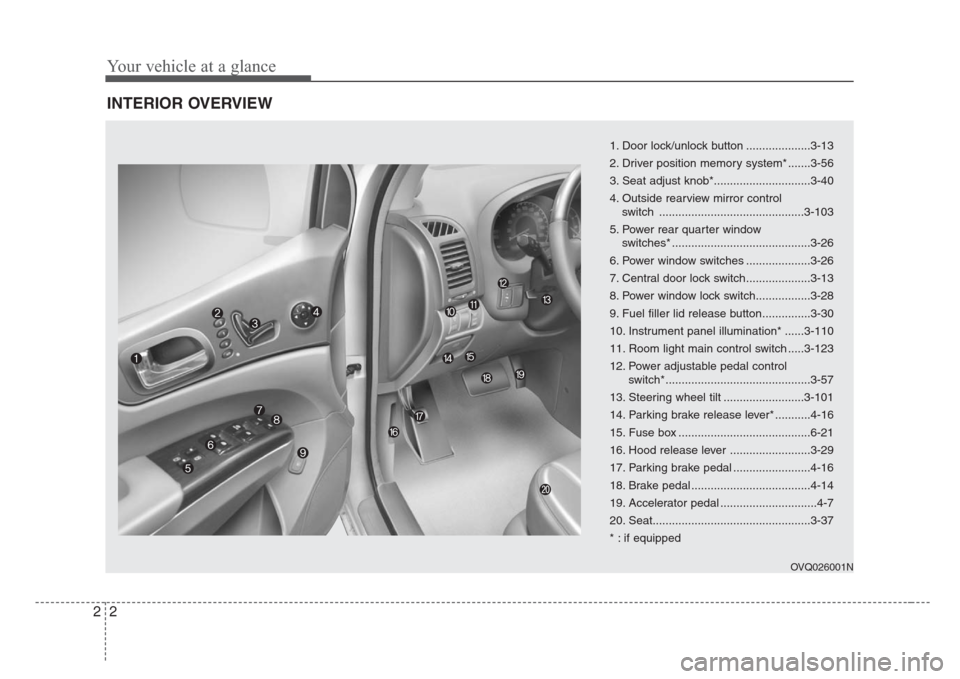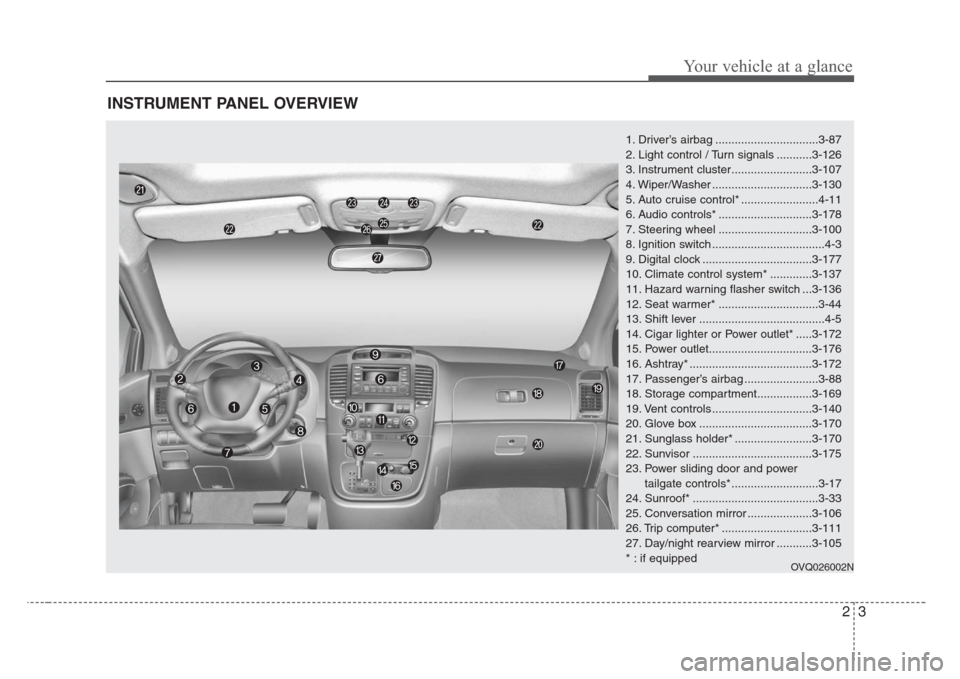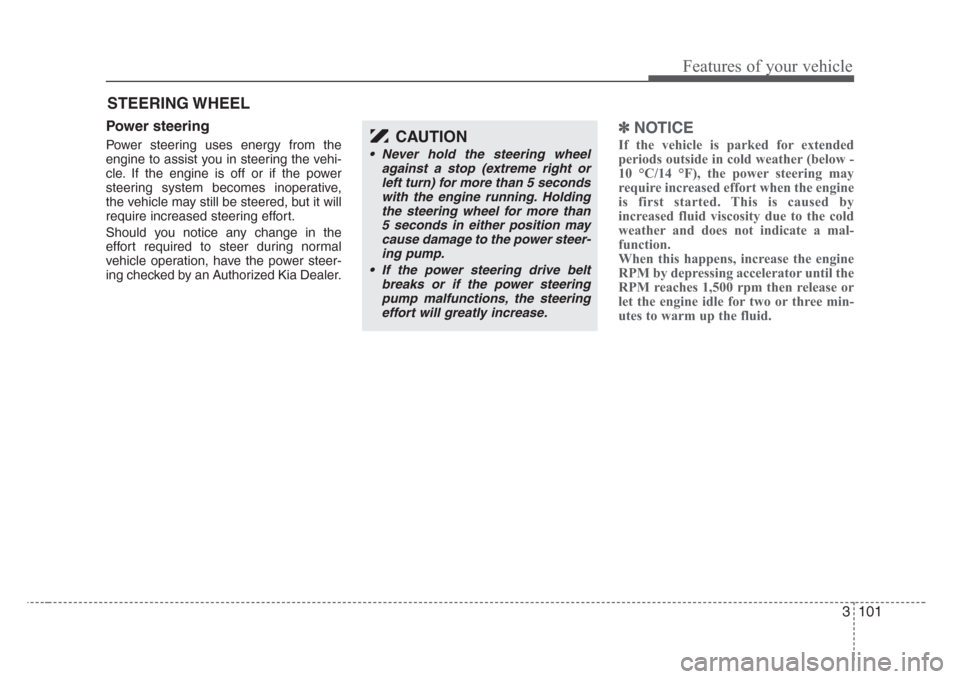2008 KIA Sedona power steering
[x] Cancel search: power steeringPage 8 of 339

Your vehicle at a glance
2 2
INTERIOR OVERVIEW
OVQ026001N
1. Door lock/unlock button ....................3-13
2. Driver position memory system* .......3-56
3. Seat adjust knob*..............................3-40
4. Outside rearview mirror control
switch .............................................3-103
5. Power rear quarter window
switches* ...........................................3-26
6. Power window switches ....................3-26
7. Central door lock switch....................3-13
8. Power window lock switch.................3-28
9. Fuel filler lid release button...............3-30
10. Instrument panel illumination* ......3-110
11. Room light main control switch .....3-123
12. Power adjustable pedal control
switch*.............................................3-57
13. Steering wheel tilt .........................3-101
14. Parking brake release lever* ...........4-16
15. Fuse box .........................................6-21
16. Hood release lever .........................3-29
17. Parking brake pedal ........................4-16
18. Brake pedal .....................................4-14
19. Accelerator pedal ..............................4-7
20. Seat.................................................3-37
* : if equipped
Page 9 of 339

23
Your vehicle at a glance
INSTRUMENT PANEL OVERVIEW
1. Driver’s airbag ................................3-87
2. Light control / Turn signals ...........3-126
3. Instrument cluster.........................3-107
4. Wiper/Washer ...............................3-130
5. Auto cruise control* ........................4-11
6. Audio controls* .............................3-178
7. Steering wheel .............................3-100
8. Ignition switch ...................................4-3
9. Digital clock ..................................3-177
10. Climate control system* .............3-137
11. Hazard warning flasher switch ...3-136
12. Seat warmer* ...............................3-44
13. Shift lever .......................................4-5
14. Cigar lighter or Power outlet* .....3-172
15. Power outlet................................3-176
16. Ashtray* ......................................3-172
17. Passenger’s airbag .......................3-88
18. Storage compartment.................3-169
19. Vent controls ...............................3-140
20. Glove box ...................................3-170
21. Sunglass holder* ........................3-170
22. Sunvisor .....................................3-175
23. Power sliding door and power
tailgate controls* ...........................3-17
24. Sunroof* .......................................3-33
25. Conversation mirror ....................3-106
26. Trip computer* ............................3-111
27. Day/night rearview mirror ...........3-105
* : if equipped
OVQ026002N
Page 10 of 339

3
Keys / 3-3
Remote keyless entry / 3-4
Theft-alarm system / 3-7
Immobilizer system / 3-9
Door locks / 3-11
Power sliding door and power tailgate / 3-17
Window / 3-26
Hood / 3-29
Fuel filler lid / 3-30
Sunroof / 3-33
Seat / 3-37
Driver position memory system / 3-57
Power adjustable pedals / 3-58
Safety belts / 3-59
Child restraint system / 3-71
Air bags-advanced restraint system / 3-78
Steering wheel / 3-101
Mirrors / 3-103
Instrument cluster / 3-108
Gauges / 3-109
Trip computer / 3-112
Features of your vehicle
Page 95 of 339

Features of your vehicle
86 3
Air bag system components
The main components of your SRS are:
• To indicate that your vehicle is
equipped with air bags, the corre-
sponding air bag covers are marked
with “SRS AIR BAG”.
- Driver’s air bag
- Passenger’s air bag
- Side air bag
- Curtain air bag
• A diagnostic system that continually
monitors the system operation.
• An indicator light to warn you of a pos-
sible problem with the system.• Emergency power backup in case your
car’s electrical system is disconnected
in a crash.
The SRS uses a collection of sensors to
gather information about the driver’s seat
position, the driver’s and front passenger’s
safety belt usage and impact severity.
The driver’s seat position sensor, which
is installed on the seat track, determine if
the seat is fore or aft of a reference posi-
tion. Similarly, the safety belt usage sen-
sors determine if the driver and front pas-
senger’s safety belts are fastened. These
sensors provide the ability to control the
SRS deployment based on how close the
driver’s seat is to the steering wheel,
whether or not the safety belts are fas-
tened, and the severity of the impact.
(Continued)
• If the driver brakes the vehicle
heavily prior to an impact, unbelt-
ed occupants will be thrown for-
ward. If the front passenger is not
wearing the safety belts, they will
be directly in front of the storage
compartment when deployment
occurs. In that situation, serious
injury or death is possible.
• Never allow front passenger to
put their hands, feet or face on or
close to the instrument panel. In
the event of air bag deployment,
such a mispositioned occupant
would be likely to suffer severe
injury or death.
• Never allow children, pregnant
women or weak persons to sit in
the front passenger seat. Do not
put child restraint system on the
front passenger's seat either.
They may be seriously injured by
the air bag inflation when air bag
deploys.
(Continued)(Continued)
• Do not put objects or stickers on
the instrument panel. Do not
apply any accessory to the front
windshield. Do not install after-
market mirrors or accessories on
the factory-installed rearview mir-
ror. Any of these could interfere
with the deployment of the air bag
or could hit your body at high
speed and cause severe bodily
injury and even death.
Page 110 of 339

3 101
Features of your vehicle
Power steering
Power steering uses energy from the
engine to assist you in steering the vehi-
cle. If the engine is off or if the power
steering system becomes inoperative,
the vehicle may still be steered, but it will
require increased steering effort.
Should you notice any change in the
effort required to steer during normal
vehicle operation, have the power steer-
ing checked by an Authorized Kia Dealer.
✽
NOTICE
If the vehicle is parked for extended
periods outside in cold weather (below -
10 °C/14 °F), the power steering may
require increased effort when the engine
is first started. This is caused by
increased fluid viscosity due to the cold
weather and does not indicate a mal-
function.
When this happens, increase the engine
RPM by depressing accelerator until the
RPM reaches 1,500 rpm then release or
let the engine idle for two or three min-
utes to warm up the fluid.
STEERING WHEEL
CAUTION
• Never hold the steering wheel
against a stop (extreme right or
left turn) for more than 5 seconds
with the engine running. Holding
the steering wheel for more than
5 seconds in either position may
cause damage to the power steer-
ing pump.
• If the power steering drive belt
breaks or if the power steering
pump malfunctions, the steering
effort will greatly increase.
Page 246 of 339

Driving your vehicle
14 4
Power brakes
Your vehicle has power-assisted brakes
that adjust automatically through normal
usage.
In the event that the power-assisted
brakes lose power because of a stalled
engine or some other reason, you can
still stop your vehicle by applying greater
force to the brake pedal than you nor-
mally would. The stopping distance, how-
ever, will be longer.
When the engine is not running, the
reserve brake power is partially depleted
each time the brake pedal is applied. Do
not pump the brake pedal when the
power assist has been interrupted.
Pump the brake pedal only when neces-
sary to maintain steering control on slip-
pery surfaces.
In the event of brake failure
If service brakes fail to operate while the
vehicle is in motion, you can make an
emergency stop with the parking brake.
The stopping distance, however, will be
much greater than normal.
BRAKE SYSTEM
(Continued)
• When descending a long or steep
hill, shift to a lower gear and
avoid continuous application of
the brakes. Continuous brake
application will cause the brakes
to overheat and could result in a
temporary loss of braking per-
formance.
• Wet brakes may result in the vehi-
cle not slowing down at the usual
rate and pulling to one side when
the brakes are applied. Applying
the brakes lightly will indicate
whether they have been affected
in this way. Always test your
brakes in this fashion after driv-
ing through deep water. To dry the
brakes, apply them lightly while
maintaining a safe forward speed
until brake performance returns
to normal.
WARNING- Parking brake
Applying the parking brake while
the vehicle is moving at normal
speeds can cause a sudden loss of
control of the vehicle. If you must
use the parking brake to stop the
vehicle, use great caution in apply-
ing the brake.
WARNING-Brakes
• Do not drive with your foot rest-
ing on the brake pedal. This will
create abnormal high brake tem-
peratures, excessive brake lining
and pad wear, and increased
stopping distances.
(Continued)
Page 257 of 339

425
Driving your vehicle
Your vehicle's fuel economy depends
mainly on your style of driving, where you
drive and when you drive.
Each of these factors affects how many
kilometers (miles) you can get from a
liter (gallon) of fuel. To operate your vehi-
cle as economically as possible, use the
following driving suggestions to help
save money in both fuel and repairs:
• Avoid lengthy warm-up idling. Once the
engine is running smoothly, begin driv-
ing. Remember, engine warm-up may
take a little longer on cold days.
• Save fuel by accelerating slowly after
stopping.
• Keep the engine in tune and follow the
recommended periodic maintenance
schedule. This will increase the life of
all parts and lower your operating
costs.• Do not use the air conditioner unnec-
essarily.
• Slow down when driving on rough
roads.
• For longer tire life and better fuel econ-
omy, always keep the tires inflated to
the recommended pressures.
• Maintain a safe distance from other
vehicles to avoid sudden stops. This
will reduce wear on brake linings and
pads. Driving in such a way will also
save fuel because extra fuel is required
to accelerate back to driving speed.
• Do not carry unnecessary weight in the
vehicle.
• Do not rest your foot on the brake
pedal while driving. This can cause
needless wear, possible damage to the
brakes, and poor fuel economy.
• Improper wheel alignment results in
faster tire wear and lower fuel econo-
my.• Open windows at high speeds can
reduce fuel economy.
• Fuel economy is less in crosswinds
and headwinds. To help offset some of
this loss, slow down when driving in
these conditions.
Keeping a vehicle in good operating con-
dition is important both for economy and
safety. Therefore, have an authorized Kia
dealer perform scheduled inspections
and maintenance.
ECONOMICAL OPERATION
WARNING - Engine off dur-
ing motion
Never turn the engine off to coast
down hills or anytime the vehicle is
in motion. The power steering and
power brakes will not function
properly without the engine run-
ning. Instead, keep the engine on
and downshift to an appropriate
gear for engine braking effect. In
addition, turning off the ignition
while driving could engage the
steering wheel lock resulting in
loss of vehicle steering which could
cause serious injury or death.
Page 283 of 339

What to do in an emergency
16 5
When towing your vehicle in an emer-
gency without wheel dollies :
1. Set the ignition switch in the ACC posi-
tion.
2. Place the transaxle shift lever in N
(Neutral).
3. Release the parking brake.
If your car must be towed
Towing with a vehicle other than a
tow truck
If towing is necessary, we recommend
you to have it done by an Authorized
Kia dealer or a commercial tow truck
service.
If towing service is not available in an
emergency, your vehicle may be tem-
porarily towed using a cable or chain
secured to the emergency towing hook
under the rear of the vehicle. Use
extreme caution when towing the vehicle.
A driver must be in the vehicle to steer it
and operate the brakes.
Towing in this manner may be done only
on hard-surfaced roads for a short dis-
tance and at low speeds. Also, the
wheels, axles, power train, steering and
brakes must all be in good condition.
• Do not use the tow hooks to pull a vehi-
cle out of mud, sand or other condi-
tions from which the vehicle cannot be
driven out under its own power.
• Avoid towing a vehicle heavier than the
vehicle doing the towing.
• The drivers of both vehicles should
communicate with each other frequent-
ly.
CAUTION
Failure to place the transaxle shift
lever in N (Neutral) may cause inter-
nal damage to the transaxle.OVQ056016N
1VQA4034
Long wheelbase
Short wheelbase